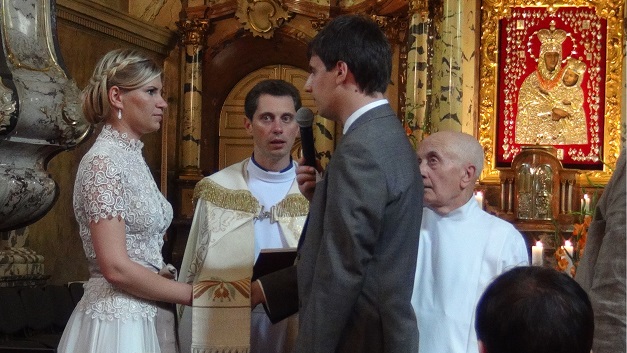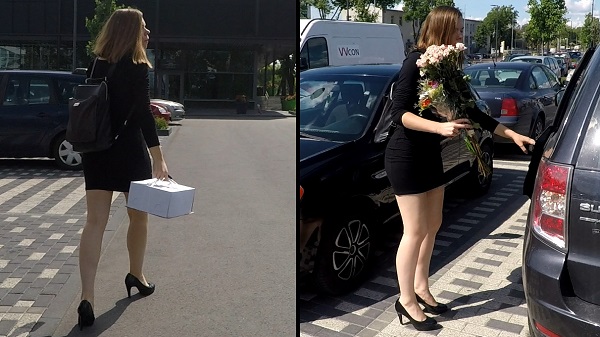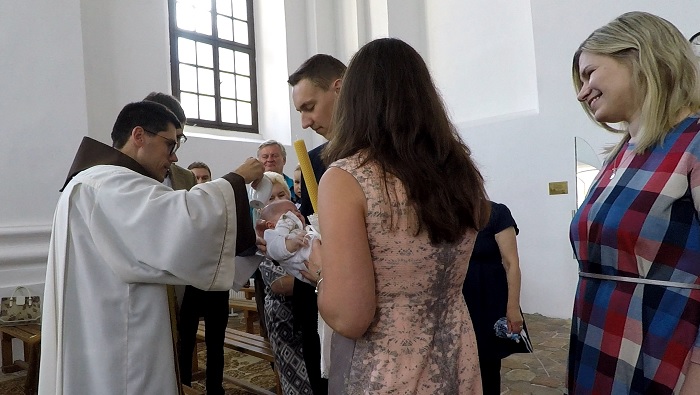Lithuanian Celebrations of Lifetime Events
Traditionally, the wedding and funeral are the most important lifetime events as they mark the beginning of a new life (family and afterlife).
Both events were traditionally seen as reasons for weeping. Relatives used to perform the weeps (improvised laments accompanied by crying). Not that surprising if you know that "ašarų pakalnė" (Valley of tears) is used as a poetic synonym for "The world" in the Lithuanian language.
Lithuanian funerals
Funerals are nearly always celebrated traditionally (according to the wishes of usually elderly deceased). They take up to several days with the first day(s) dedicated to the presentation of the dead body. All the people who knew the deceased then come for a final look and a few minutes (hours in case of the closest friends) of contemplation. They also bring weaths and flowers and tell their condolences. In villages, this used to be done at home with vigils at night but now a funeral house is typically rented out (which are closed at nights). Christian carols by professional singers now have largely replaced the weeps.
The final day of a funeral includes a priest visit and the "final goodbye" (touching/kissing of the deceased by closest relatives) followed by the funeral procession to a cemetery (in villages the hearse is followed on foot). Amidst prayers and final words the casket is lowered and the hole then filled. Numerous flowers and wreaths brought in throughout visiting days are put on the grave together with a wooden cross (to be replaced by a tombstone a year later). Dinner of grief follows where friends and relatives are invited and Christian carols also performed. Such dinner is repeated after a year and holy mass for the deceased is celebrated at every anniversary of death.
BOTTOM LEFT: a family grave with three gravestones for those died over 1 year ago and a wooden cross for a recent burial. TOP: Large cemetery chapels such as this used to house the remains of nobility families but are no longer constructed. ©Augustinas Žemaitis.
Cremations are rare (the first crematory was constructed in Lithuania in 2011) and when they are done, the traditional rites may still be followed where possible, with casket replaced by an urn.
The length of funeral and a cultural emphasis on care of the graves (which are covered by elaborate tombstones and flower gardens) make some say that there is a cult of death in Lithuania somewhat reminiscent to that in Mexico.
Lithuanian weddings
The high-point of a wedding is usually the sacramental celebration in church (long form with holy mass which takes ~1 hour or short form without one). Some people opt for a non-religious wedding performed at the Soviet-established "wedding palaces" (although now possible to be done anywhere). A decreasing number of others do both (this was a must for the religious families in the Soviet Union when church weddings were not recognized by law. Today however such practice is just a mean to make that special day last longer).

Taking oath at the main altar of a Lithuanian Roman Catholic church. Left-to-right: wife, priest, husband, assistant of the priest. ©Augustinas Žemaitis.
Everybody may participate in the ceremony and a short (~1 hour long) "microparty" that follows it in a nearby street, yard or venue.
The main party is held that evening in a hired restaurant or farmstead and usually ends the following day. Only the friends and relatives are invited there. Some old traditions are still quite common, such as a supposed "hanging" of the matchmaker (who is saved by bride) or the matchmaker buying the right to sit at a table. In the countryside, wedding cars may be blocked by other people asking for candies.
Rue laurels traditionally symbolized virginity and were made for the bride during her bachelorette party. Today, bachelor(ette) parties are usually celebrated the Western way. Matchmaking parties, once celebrated some 20 days before a wedding, are gone altogether.
Until the 1990s it was common to marry after ~1 year of friendship (this was influenced as much by Christian traditions as by the Soviet system which forbade unmarried couples from even sharing a hotel room). Today, 3, 5 or even 10 years of cohabitation pass until a couple agrees to marry (that's why there are fewer rue laurels...). Some people prefer to spend vast money on the wedding (dress, photographer, musicians, good restaurant, rings, limousines, and honeymoon) facilitating the need for a career before the wedding (it all used to be much cheaper when celebrated at home).
Birthdays and name days
Birthdays are celebrated the Western way with parties and presents. However, some people (primarily females past their 30s) avoid this as getting older brings them negative feelings. Co-workers greet the person during the workday closest to his birthday.

A woman brings cake for her co-workers at the morning of her birthday (left) and brings back home flowers she received from her co-workers after the workday (right). ©Augustinas Žemaitis.
Name days exist for every Lithuanian name but they are usually not celebrated save for a few particular Christian names (e.g. Jonas - John).
Childhood, teenage and youth celebrations
Christian ceremonies celebrated by children (and their parents) are the sacraments of Christening, First Communion and Confirmation (at ~1 year, ~12 years and ~14 years respectively). During the Christening (infant baptism), a baby is given a name and accepted into the Christian community. Before receiving his/her First Communion one learns prayers and makes the first confession. Confirmation is granted by the bishop and requires person's further determination to be Christian. In practice, Christening is often seen as a must even for some non-religious parents, whereas later sacraments may feel more optional.

Christening of a baby. Holy water is poured by a priest as his parents (on the sides) and Christening parents (in front) watch. Traditionally, "Christening parent" is a symbollic obligation one accepts to help the child throughout his life and help him be Christian, although these days often the Christening parents have little to do with child's life and just help perform the ritual. ©Augustinas Žemaitis.
Most secular "initiation rites" are related to educational milestones. The person's first (~7 years old) and final (~18 years old) schoolyear beginnings (September 1st) are held as important (parents also participate).
The final schoolyear includes a bunch of other celebrations: Šimtadienis (celebrated in March, 100 days before the final lesson), Final bell (final day at school named so after electric bells used in Lithuanian schools to invite students to lessons; June) and prom night (June or July).
Undergraduate studies are completed by the majority of young Lithuanians followed by graduation.
Generally, various personal holidays (especially weddings and birthdays) have been associated with heavy alcohol consumption but today many people celebrate without getting drunk.



June 21st, 2023 - 10:40
Is April 11th, 30th and September 30 birthdays rare in Lithuania?
June 29th, 2023 - 03:18
Why should they be? Never heard anything about it.